Daytime Adaptive Optics for Deep Space Optical Communication

Project Objectives
Future deep space missions will tax the ability of existing radio frequency systems to return all the data. In addition, these missions must be able to communicate around the clock, including when the spacecraft is near the Sun. This is especially true for crewed missions. Optical communication can solve these problems, and also offers the promise of being more compact and using less power and mass. Traditional deep space optical communication concepts require large diameter telescopes (>8m) to collect enough photons to provide adequate signal-to-noise ratio. Systems operating during the day will experience strong turbulence which results in large point spread functions. This necessitates photon counting detectors with a large field-of-view which are difficult to build. The large field-of-view also lets in excessive sky background which degrades the communication performance. Adaptive optics (AO) can mitigate this degradation by concentrating the light and thus not needing a large field of view. We assumed a DSOC style mission to Mars to provide estimates of how bright the downlink power, the range, the wavelength, aperture size and range of elevation angles. We then computed what data rate is achieved for a variety of telescope diameters for a given Strehl ratio.

As you can see the data rate plateaus after achieving a fairly low Strehl ratio.
Why does this work?

On the left is a uncompensated PSF, while the image on the right is the image after the AO system was turned on. When the AO system is turned on the PSF shrinks dramatically, but it still leaves behind a core of uncompensated light. If we shrink the FOV of the SNSPD as the PSF shrinks, we eliminate the vast majority of the background light. This improves the detection of the communication signal.
As the AO system improves performance, light is moved from the halo into the core. To get most of the light into the core only requires a moderate amount of AO correction. This is different for AO systems working with coherent detection schemes such as DPSK that work with single mode fibers, (LCRD is a prime example of this.) in those cases, the light coupled into the is proportional to the Strehl ratio and work best with very high Strehl ratios.
The images above were taken at night and the uncompensated image had a full width half-maximum (FWHM) of 2.6 μradians. Images taken during the day at low elevation would have FWHM 10 to 20 larger and will make the improvement even more dramatic.
Significance of Results
The data shows that a 4-m telescope with a modestly performing AO system can achieve equivalent performance to a 12-m telescope with no AO system for daytime optical communications. This will result in a dramatic cost savings. In addition, a 4-m telescope has a much smaller physical footprint and would be easier to insert into existing facilities.
Publications
Daytime Adaptive Optics for Deep Space Optical Communication
Lewis C. Roberts Jr., Seth Meeker, Sabino Piazzola, J. Chris Shelton
Proc. SPIE, vol. 11330, 113308 (2019)
Copyright 2019 Society of Photo Optical Instrumentation Engineers. https://doi.org/10.1117/12.2524633
